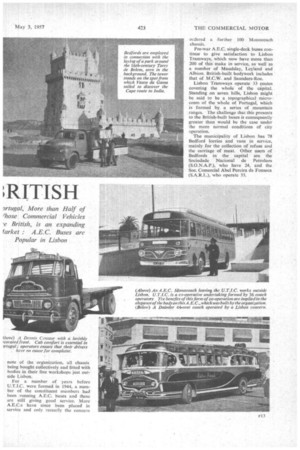RTUGAL BUY
Page 102

Page 103

If you've noticed an error in this article please click here to report it so we can fix it.
9rtugal, More than Half' of 'hose Commercial Vehicles .e British, is an expanding farket A.E.C. Buses are Popular in Lisbon
pORTUGAL has not in the past been a big market for British commercial vehicles. Its imports of vans, lorries and buses from the United Kingdom since the war represent a mere £17m., which is infinitesimal compared with purchases by the Australian and South African markets.
Nevertheless, despite the proximity of Portugal to the Continent and the fact that it is outside the scope of British imperial preferences, some 56 per cent, of the commercial vehicles now operating there were bought from Britain.
Last year, 2,871 commercial vehicles, valued at nearly £2,2m., were imported from the United Kingdom. These figures were more than double those for 1946, and were far in excess of purchases made in other countries.
And the market is expanding at a rate in keeping with Poftugal's • tightly reined and highly successful economy, which at once strikes a note of confidence for overseas sellers. In 1946, Portugal had one commercial vehicle for every 598 persons; by last year the ratio had increased to one for every 194 persons. This compares with a ratio of one to 40 in Britain.
Relatively small though the Portuguese market is, it has for many years represented a steady source of income to the British cOmmercial vehicle industry, and there is no reason to suppose that this situation wilt change. Only a few weeks ago, against keen competition from Continental makers, British United Traction Co., Ltd., secured from the Oporto municipality an order for 20 trolleybus chassis. Bodies will be built locally.
, This order may well be significant in another way, because these trolleybuses will be the first to be placed in service in Oporto, where they will replace trams. The vast hydro-electric power schemes which the Portuguese Government now have well under way pose the question whether Portugal will become one of the world's few expanding markets for trolleybuses.
F 1 2 Support for this conjecture can be found in the university town of Coimbra, where Sunbeam and RUT. trolley buses have been introduced within the past six years. The Sunbeams. which are fitted with British Thomson-Houston electrical equipment, have Park Royal bodies with seats for 40 persons and standing room for another 30.
They and the B.U.T. vehicles are reported to be giving complete satisfacdon under conditions which, with many steep gradients and poorly, surfaced roads, can hardly be described as ideal. The trolleybuses for Oporto will also have British electrical equipment, the manufacturers " in this case being Metropolitan-Vickers.
The municipal • undertakings of Oporto and Coimbra also operate a number of Daimler motorbuses. A.E.C. Regals also form part of the Oporto fleet. Private operators run Daimler, A.E.C. and Leyland vehicles on intercity services, as well as on tours of Portugal, Spain, France and Italy.
Capristano and Ferreira, Ltda., of Caldas da Rainha, have more than 40 Guys on tour work in Portugal and other countries. Thirty-five of these are uhderfloor-engined Arab 43-seaters, and the remainder Otter and Wolf models, the latter having only 18 seats. All have locally bnilt bodies.
Some 85 per cent, of all the coaches in Portugal are run by U.T.I.C., an organization comprising 36 individual operators. Centralization is the key note of the organization, all chassis being bought collectively and fitted with bodies in their fine workshops just outside Lisbon.
For a number of years before U.T.I.C. were formed in 1944, a number of the constituent members had been running A.E.C. buses and these are still giving good service. More A.E.C.s have since been placed in service and only recently the concern
ordered a further 100 Monocoach chassis.
Pre-war A.E.C. single-deck buses continue to give satisfaction to Lisbon Tramways, which now have more than 200 of this make in service, as well as a number of Maudslay, Leyland and Albion. British-built bodywork includes that of M.C.W. and Saunders-Roe.
Lisbon Tramways operate 33 routes covering the whole of the capital. Standing on seven hills, Lisbon might be said to be a topographical microcosm of the whole of Portugal, which is formed by a series of mountain ranges. The challenge that this presents to the British-built buses is consequently greater than would be the case under the more normal conditions of city operation.
The municipality of Lisbon has 78 Bedford lorries and vans in service, mainly for the collection of refuse and the carriage of meat. Other users of Bedfords in the capital are the Sociedade Nacional de Petroleos (S.O.N.A.P.), who have 24, and the Soc. Comercial Abel Pereira da Fonseca (S.A.R.L.), who operate 33.












































































































































































































































